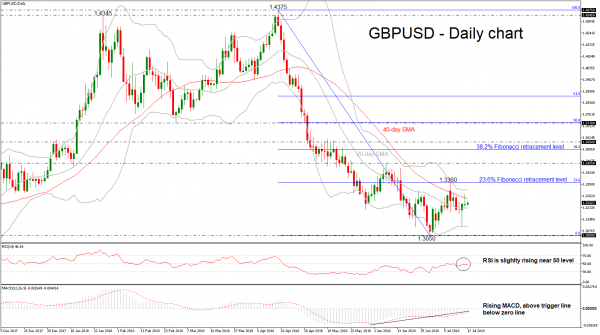GBPUSD has been trading in a neutral mode over the last couple of days after the rebound on the lower Bollinger Band near 1.3100 on July 13. The price seems to be losing its strong negative momentum as the Bollinger Band is narrowing and suggests that the next movement will be sideways. It is worth mentioning that the cable is still developing below the 23.6% Fibonacci retracement of the downleg from 1.4375 to 1.3050, around 1.3360.
In the daily timeframe, the technical indicators are recommending a slight upside bias. The RSI indicator is rising with weak momentum near the threshold of 50, while the MACD oscillator is still moving above its trigger line but remains in the negative territory. Still, downside risks have not faded out yet as both indicators continue to fluctuate in bearish zones.
Should the price climb above the 40-day simple moving average (SMA) of 1.3267 and the upper Bollinger Band of 1.3318 at the time of writing, investors would turn their eyes towards the 23.6% Fibonacci of 1.3360. In case of further gains, bulls could push the pair until the 1.3475 resistance level, taken from the high on June 7. Clearing this level, the price could top the 38.2% Fibonacci mark of 1.3556.
Conversely, a decline could find support at the mid-level of the Bollinger Band (20-day SMA), where if the bearish moves appear stronger, the price could hit the lower Band near the 1.3100 psychological level. A failure to hold above this level would open the way for the 1.3050 support where the price bottomed during June. If there is a drop below this region the next level to have in mind is the 1.2770 support, identified by August 2018.
In the medium term, the neutral to bearish outlook remains intact, with the Bollinger Band appearing to follow a sideways movement and the price holding within the 20- and 40-day SMAs. Having a look at the weekly timeframe, the 20-SMA is ready for a bearish crossover with the 40-SMA.














